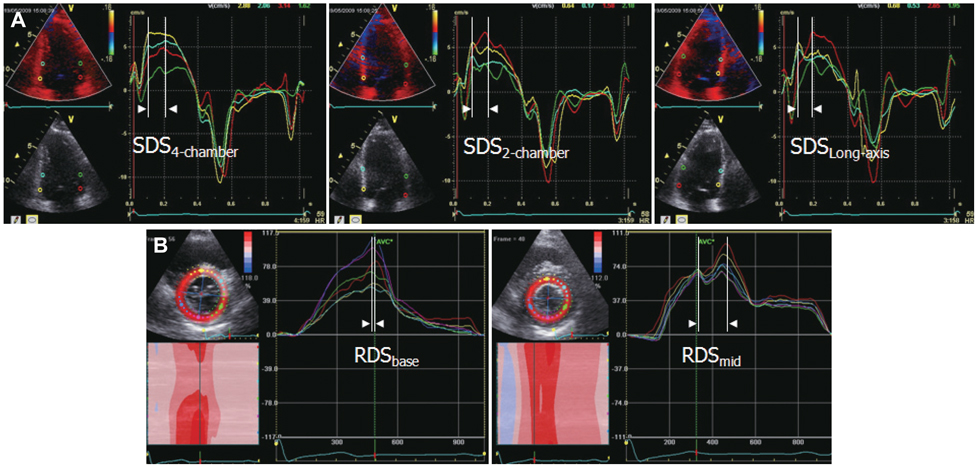Korean Circ J.
2011 Jan;41(1):16-22. 10.4070/kcj.2011.41.1.16.
Improvement in Left Ventricular Systolic Dyssynchrony in Hypertensive Patients After Treatment of Hypertension
- Affiliations
-
- 1Department of Cardiology, Fatima General Hospital, Daegu, Korea. Augustjbc@yahoo.co.kr
- KMID: 2225149
- DOI: http://doi.org/10.4070/kcj.2011.41.1.16
Abstract
- BACKGROUND AND OBJECTIVES
Left ventricular (LV) dyssynchrony has been commonly detected among hypertensive patients with normal LV systolic function and no evidence of congestive heart failure. The purpose of our study was to assess the changes in LV systolic dyssynchrony (SDSLV) among hypertensive patients after antihypertensive treatment, and to determine the relationship between SDSLV and other conventional echocardiographic parameters.
SUBJECTS AND METHODS
Forty one hypertensive patients with normal LV ejection fraction were enrolled. By performing a conventional echocardiographic study, the SDSLV was measured as the time difference between the shortest and longest time of the peak myocardial systolic velocities among 12 segments of the basal and mid-levels of the 3 apical views, and radial dyssynchrony of the basal (RDSbase) and mid-levels (RDSmid) measured as the time difference between the earliest and latest peak values on the radial strain curves of each level of the parasternal short-axis views.
RESULTS
Compared to baseline after six months of antihypertensive treatment, the SDSLV improved significantly (48.7+/-37.9 ms vs. 29.5+/-34.1 ms, p=0.020). Also the RDSbase and RDSmid improved significantly in respect to the baseline values (129.9+/-136.3 ms vs. 38.8+/-45.4 ms, p=0.002 and 75.2+/-63.8 ms vs. 28.2+/-37.7 ms, respectively, p<0.001).
CONCLUSION
The severity of SDSLV improved with antihypertensive treatment, and was associated with the regression of LV mass. Furthermore, it might precede improvement in the mitral inflow pattern, as assessed by conventional echocardiography, so that early detection of the benefit of antihypertensive treatment may be possible.
Figure
Reference
-
1. Zile MR, Brutsaert DL. New concepts in diastolic dysfunction and diastolic heart failure: I. diagnosis, prognosis, measurements of diastolic function. Circulation. 2002. 105:1387–1393.2. Poulsen SH, Anderson NH, Ivarsen PI, Mogensen CE, Egeblad H. Doppler tissue imaging reveals systolic dysfunction in patients with hypertension and apparent "isolated" diastolic dysfunction. J Am Soc Echocardiogr. 2003. 16:724–731.3. Aurigemma GP, Silver KH, Priest MA, Gaasch WH. Geometric changes allow normal ejection fraction despite depressed myocardial shortening in hypertensive left ventricular hypertrophy. J Am Coll Cardiol. 1995. 26:195–202.4. Penicka M, Bartunek J, De Bruyne B, et al. Improvement of left ventricular function after cardiac resynchronization therapy is predicted by tissue Doppler imaging echocardiography. Circulation. 2004. 109:978–983.5. Leclercq C, Faris O, Tunin R, et al. Systolic improvement and mechanical resynchronization does not require electrical synchrony in the dilated failing heart with left bundle-branch block. Circulation. 2002. 106:1760–1763.6. Wang J, Kurrelmeyer KM, Torre-Amione G, Nagueh SF. Systolic and diastolic dyssynchrony in patients with diastolic heart failure and the effect of medical therapy. J Am Coll Cardiol. 2007. 49:88–96.7. Yu CM, Zhang Q, Yip GWD, et al. Diastolic and systolic asynchrony in patients with diastolic heart failure. J Am Coll Cardiol. 2007. 49:97–105.8. Yang B, Chettiveettil D, Jones F, Aguero M, Lewis JF. Left ventricular dyssynchrony in hypertensive patients without congestive heart failure. Clin Cardiol. 2008. 31:597–601.9. Chobanian AV, Bakris GL, Black HR, et al. Seventh report of the Joint National Committee on Prevention, Detection, Evaluation, and Treatment of High Blood Pressure. JAMA. 2003. 289:2560–2572.10. McKee PA, Castelli WP, McNamara PM, Kannel WB. The natural history of congestive heart failure: the Framingham study. N Engl J Med. 1971. 285:1441–1446.11. Ommen SR, Nishimura RA, Appleton CP, et al. Clinical utility of Doppler echocardiography and tissue Doppler imaging in the estimation of left ventricular filling pressures: a comparative simultaneous Doppler-catheterization study. Circulation. 2000. 102:1788–1794.12. Suffoletto MS, Dohi K, Cannesson M, Seba S, Gorcsan J 3rd. Novel speckle tracking radial strain from routine black-and-white echocardiographic images to quantify dyssynchrony and predict response to cardiac resynchronization therapy. Circulation. 2006. 113:960–968.13. Gorcsan J 3rd, Tanabe M, Bleeker GB, et al. Combined longitudinal and radial dyssynchrony predicts ventricular response after resynchronization therapy. J Am Coll Cardiol. 2007. 50:1476–1483.14. Sokolow M, Lyon TP. The ventricular complex in ventricular hypertrophy as obtained by unipolar precordial and limb leads. Am Heart J. 1949. 37:161–186.15. Nagueh SF. Mechanical dyssynchrony in congestive heart failure. J Am Coll Cardiol. 2008. 51:18–22.16. Hawkins NM, Petrie MC, MacDonald MR, Hogg JK, McMurray JJ. Selecting patients for cardiac resynchronization therapy: electrical or mechanical dyssynchrony? Eur Heart J. 2006. 27:1270–1281.17. Bleeker GB, Holman ER, Steendijk P, et al. Cardiac resynchronization therapy in patients with a narrow QRS complex. J Am Coll Cardiol. 2006. 48:2243–2250.18. Kass DA. An epidemic of dyssynchrony: but what does it mean? J Am Coll Cardiol. 2008. 51:12–17.19. Wang J, Kurrelmeyer KM, Torre-Amione G, Nagueh SF. Systolic and diastolic dyssynchrony in patients with diastolic heart failure and the effect of medical therapy. J Am Coll Cardiol. 2007. 49:88–96.20. Wang YC, Hwang JJ, Lai LP, et al. Coexistence and exercise exacerbation of intraleft ventricular contractile dyssynchrony in hypertensive patients with diastolic heart failure. Am Heart J. 2007. 154:278–284.
- Full Text Links
- Actions
-
Cited
- CITED
-
- Close
- Share
- Similar articles
-
- The Association of Left Ventricular Hypertrophy with Intraventricular Dyssynchrony at Rest and during Exercise in Hypertensive Patients
- Interrlationship between Left Ventricular Mass and Diurnal Variations of Blood Pressure in Patients with Esssntial Hypertension
- Impact of Left Bundle Branch Block on Left Atrial Dyssynchrony and Its Relationship to Left Ventricular Diastolic Function in Patients with Heart Failure and Dilated Cardiomyopathy
- Left Ventricular Dyssynchrony in Patients Showing Diastolic Dysfunction without Overt Symptoms of Heart Failure
- Effect of Left Ventricular Hypertrophy on Ventricular Performance in Essential Hypertension



